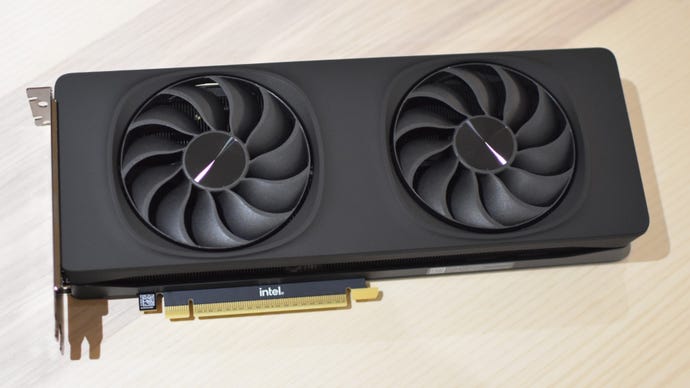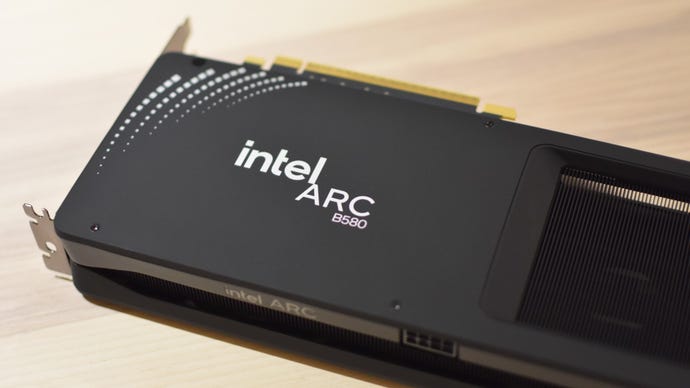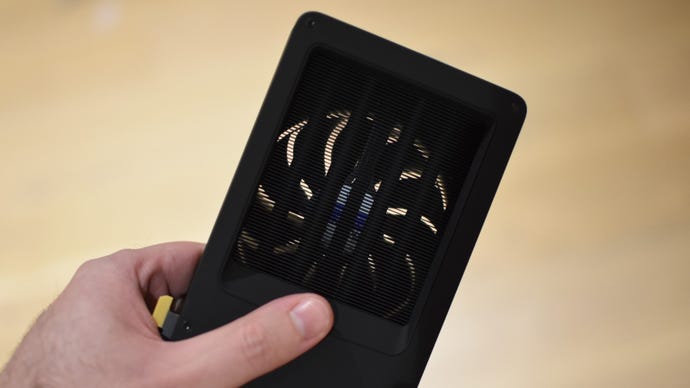It’s no longer being spelt out brazenly, however there’s a whiff of Intel’s new Battlemage GPUs being pitched as what the Alchemist technology will have to were. The ones in the end grew into their PCIe footwear, however best after months of dial-shifting motive force updates – while the flagship B580 guarantees Nvidia-besting video games efficiency from the off. Even at this sort of degree within the present graphics technology (the GeForce RTX 5090 and RTX 5080 may well be printed actually this night, at CES 2025), there’s something engaging about that proposition.
It is helping, clearly, that the B580 isn’t competing with the RTX 5090 or 5080, which is able to definitely price about the similar as the quantity of Fabergé eggs you’d want to crack to make an unpleasantly sharp marriage ceremony cake. As a substitute, and in spite of Intel’s advice that it’s a 1440p gadget, the B580 is a lot more of a 1080p-bopping RTX 4060 rival. Right here in the United Kingdom, its pricing vary is kind of lifeless even with Nvidia’s GPU, with the most cost effective beginning at £270 and Intel’s personal Restricted Version (on take a look at right here) costing £300. Stateside, it’s even less expensive, with the Restricted Version best soliciting for $260 when maximum RTX 4060 fashions are sticking round $300.
That minus-forty bucks additionally occurs to pay for 4GB extra VRAM than the 4060, the B580 packing 12GB of GDDR6. It nonetheless calls for Resizeable BAR to paintings correctly, however the Battlemage structure goals a number of weaknesses of Alchemist as smartly, tuning up its ray tracing cores and now not referring to DirectX 9 video games with this sort of glance of revulsion and worry. Which all sounds beautiful – lord is aware of the arena may just do with extra cheap-ish GPUs that aren’t, like AMD’s Radeon 7600, more or less needless.

Intel Arc B580 evaluate: 1440p benchmarks
In the real operating of video games, then again, getting probably the most out the Arc B580 isn’t so simple as slapping on ReBAR. First, at Intel’s most popular rez of 2560×1440, it controlled just a quite decent-ish appearing when paired with the RPS take a look at rig’s Core i5-11600K. Excluding modest, single-digit framerate benefits in Metro Exodus and F1 2022, it plays close to sufficient identically to the just about two-year-old RTX 4060, even with all that bonus reminiscence.
Factor is, I’ve been short of to replace our GPU benchmark procedure for ages, what with all these video games both being outmoded by means of sequels or getting about as lengthy within the enamel because the i5-11600K itself. I subsequently made up our minds to prevent hanging it off and check out a refreshed gadget, with more moderen video games and a PC primarily based across the Core i9-13900K. Much less of a representative-of-the-masses CPU, most likely, however one that are meant to be much less vulnerable to bottlenecking than the previous i5.
With this more youthful, sooner processor to play off, the B580 grew to become its drawing efficiency towards the RTX 4060 right into a blank sweep victory:
Take a look at it, capturing up from 3fps in the back of in Shadow of the Tomb Raider (granted, with other anti-aliasing) to 12fps forward. And in Metro Exodus, the RTX 4060 didn’t receive advantages in any respect from the CPU improve, however the Arc B580 claimed some other 5fps.
In contrast to the Radeon 7600, and for that topic maximum AMD GPUs, the B580 too can give Nvidia a run for his or her cash on ray tracing. Working Cyberpunk 2077 at the upgraded rig with Psycho-level RT results and max-quality upscaling, the Arc B580 averaged 39fps with XeSS – lifeless even with the RTX 4060 the use of DLSS. Flicking on Extremely-quality ray tracing in Metro Exodus additionally noticed the Arc B850 stay its lead, scoring 52fps to the RTX 4060’s 43fps. And that used to be with none upscaling lend a hand in any respect.
Intel Arc B580 evaluate: 1080p benchmarks
I’m nonetheless no longer certain that the Arc B580 is the 1440p discount that Intel say it’s – it’s obviously succesful at that solution, nevertheless it’s additionally simply scraping 60fps in more moderen video games, and for simply an additional £70 or so would get the a lot sooner RTX 4060 Ti. Down at 1080p, alternatively, it’s all easy crusing, despite the fact that the RTX 4060 is regularly sooner at the previous take a look at rig.
With the Core i9-13900K, even though, it’s some other win for Battlemage, pulling a couple of double-digit leads over the RTX 4060 and best falling quite in the back of in Murderer’s Creed Mirage.
Once more, there wasn’t a lot sunlight between the 2 within the ray-traced Cyberpunk 2077 take a look at – the Arc B580 were given 58fps, the RTX 4060 were given 59fps – and with Extremely RT enabled in Metro Exodus, Intel’s GPU remained sooner, averaging 149fps to the GeForce’s 142fps. Since F1 2024’s Extremely Prime preset additionally allows ray tracing by means of default, it too displays that the Arc B580 can face up to the added pressure with out buckling.
There’s quite a lot of excellent stuff right here, despite the fact that you’re no longer actively part-shopping, and simply need to see one thing chip away on the one-party state this is recent graphics playing cards. Nvidia is now not the one producer that may do ray tracing smartly, and will now not declare undisputedly to make the quickest sub-£300 card of the present technology – at local rez, anyway. Even the RTX 4060’s superb energy potency doesn’t pass unchallenged: the Arc B580 would seem to be the loser right here, with its 190W energy draw ranking and 600W PSU requirement dwarfing that of the 4060’s 115W ranking and 550W requirement. In apply, even though, the best possible I recorded the B580 drawing used to be simply 118W, beating the 126W I noticed at the 4060. This Restricted Version type runs cooler as smartly, normally staying round 63°c beneath load; its Nvidia rival flicked round 69-74°c vary.
Like I say, excellent stuff. On the other hand, the Arc B580’s reliance on CPU brawn additionally signifies that private viewpoint applies way more keenly than it might to the standard bar graph comparisons. Does this card do smartly to leverage more moderen CPU tech to eke out a efficiency benefit, or is it in truth yoked to the newest, costliest chips in this sort of manner that renders it a non-starter to these on older PCs?

Truthfully, I feel it’s somewhat of each. Holding in thoughts that less expensive graphics playing cards generally tend to naturally in finding their manner into in a different way growing old desktops, it’s for sure no longer superb for the Arc B580’s highest features to be so carefully connected the improve of some other, moderately pricey element. On the identical time, it’s no longer like there’s a stone-carved requirement for the latest Core i9. My earlier CPU checking out means that the i9-13900K isn’t in truth that a lot sooner than the mid-range Core i5-13600K, which is itself best marginally sooner than the Core i5-12600K, which is 3 generations previous at this level. In different phrases, the Arc B580 may just lose out in an older PC setup, however any person who’s up to date in the previous couple of years it will be high-quality.
It is not simply ray tracing the place Intel is catching up, both. It’s recently best launched and purposeful in F1 24, however XeSS 2 – the newest model in their DLSS-like upscaling tech – supplies some other instrument for the Arc B580 to crank up its framerates. Thus far, XeSS 2 seems like a fit for DLSS on normal visible high quality – rather the success, taking into consideration AMD FSR has been attempting and failing for years – and its new body technology element additionally does an excellent task of replicating DLSS 3’s AI-generated smoothness spice up. Beating it, even. That 45fps at 1440p become 80fps with XeSS 2 on, whilst at 1080p it lept from 56fps to 102fps, in each instances emerging above the respective 57fps and 77fps that the RTX 4060 produced with DLSS 3.
Once more, AMD have tried one thing very equivalent with FSR 3, however XeSS 2 turns out to supply better-looking effects with out including as a lot enter lag. I’d be prepared to check out out XeSS 2 in one thing twitchier than a gamepad-controlled racer, however what F1 24 displays up to now is encouraging.

The catch, thoughts, is that DLSS 3 has had an enormous head get started on recreation improve, recently being to be had in over 100 video games and with dozens extra at the manner. It’s onerous to look XeSS 2 catching up, ever, which means that that DLSS 3 stays a extra treasured characteristic – and that worth is transferred to the GPUs that improve it, together with the RTX 4060.
As such, the Arc B580 doesn’t rather make the RTX 4060 out of date. Nvidia will most likely stay first dibs on doing that themselves, with the inevitable RTX 5060. The GeForce may be a more secure wager for 1080p rigs which can be nonetheless the use of the CPUs of yesteryear, as the truth that it doesn’t receive advantages as a lot from more moderen chips tells us that it additionally gained’t lose out as a lot with older chips.
Conversely, for all-new builds (or PCs which have been freshened up outdoor the GPU), the Arc B580 is a reputable selection. Arguably the easier one, in truth, if you’ll be able to reside with out a extra broadly to be had flavour of body gen. But even so solving Alchemist’s ray tracing weak spot and normally stabilising the entirety – I’ve skilled not one of the crashing that I did with the Arc A750 – the Battlemage structure has produced a pleasantly peppy, inexpensive GPU that’s greater than sufficient for slick 1080p. And it doesn’t even want twenty motive force updates to get there.
This evaluate is according to a retail unit equipped by means of the producer.















